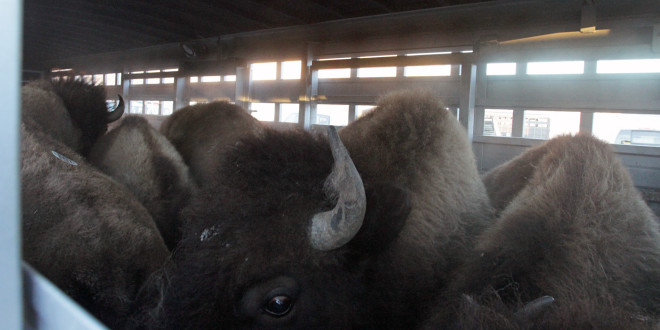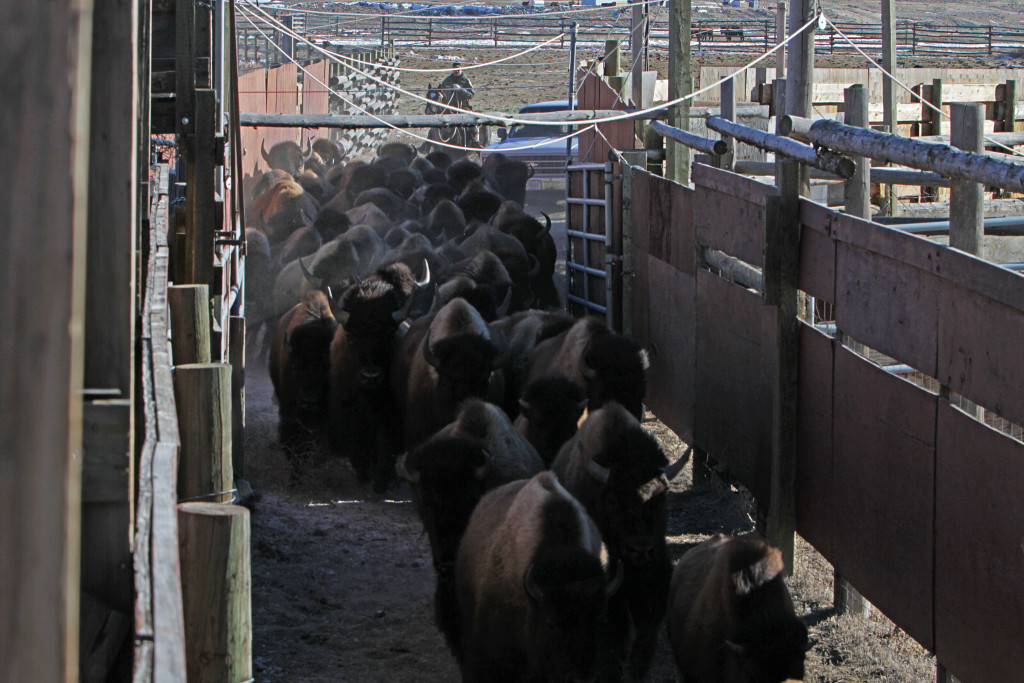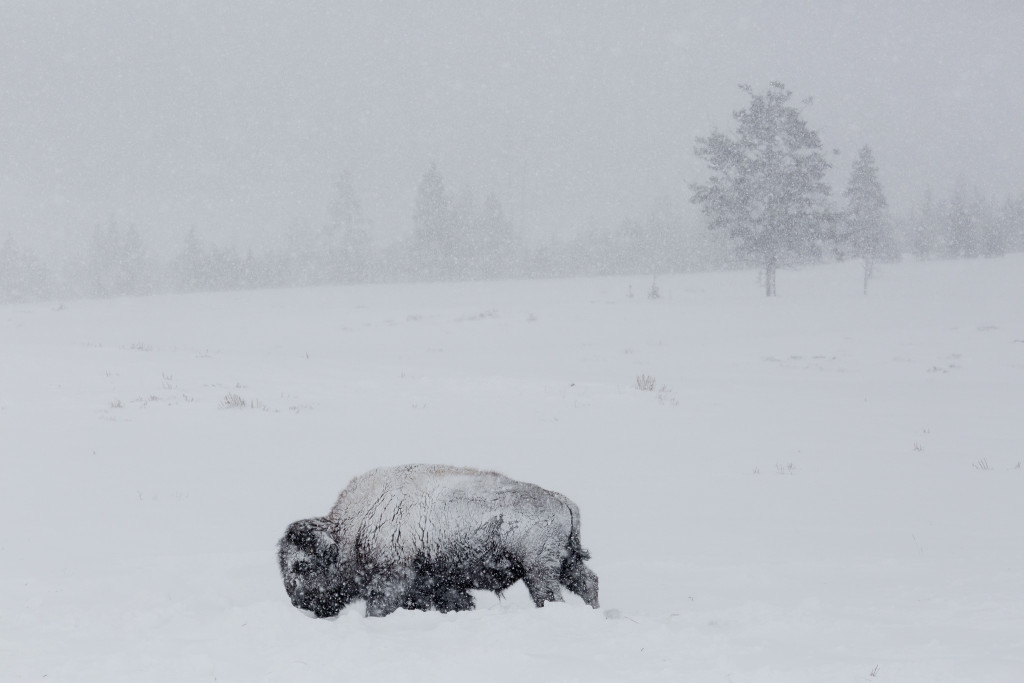A journalist and a wild bison advocate have sued the National Park Service over access to Yellowstone’s Stephens Creek Bison Capture Facility.
Joining the Animal Legal Defense Fund; Wyoming law firm Fuller, Sandefer and Associates, as well as two University of Denver constitutional law professors, journalist Christopher Ketcham and Buffalo Field Campaign representative Stephany Seay allege Yellowstone National Park has violated the public’s First Amendment rights by closing access to the facility where bison are captured, sorted, and shipped annually for slaughter under the Interagency Bison Management Plan.
Further, ALDF attorney Stefani Wilson has said they hope to suspend the planned slaughter until an access agreement is reached, according to the Bozeman Daily Chronicle:
They are asking the court to order the park to let the public watch the bison slaughter operations — including trapping, sorting and shipping — at its Stephens Creek facility near Yellowstone National Park’s northern edge. No bison will be trapped there until after Feb. 15.
The facility is generally off-limits to the public. The park held one tour earlier this month while the facility was empty, and has promised to allow guided access twice more this year when bison are there and will be shipped.
[…]
Seay said the park had let the public watch the capture of bison in the past, but had stopped allowing access. She said in the past few years, the park had “just kind of shut off the public, and they’re not telling us what’s going on in a timely manner.”
Ketcham, who has written about bison for Vice and Harper’s, compared the closure of the area to so-called “Ag-Gag” laws that have been used in several states to deny media and public access to agricultural operations. One recent example of that law was struck down in Idaho last year, and Ketcham said he thinks the park’s moves to limit access to Stephens Creek will face the same fate.
“I don’t think it will stand the test of the courts,” he said.
Wilson added she expects the court (the U.S. District Court in Wyoming) to act within the next two weeks.
Stephens Creek: Site of Controversy
Since 2006 (and earlier and, undoubtedly, going ahead) the Stephens Creek pen has been the site of much contention regarding Yellowstone’s bison population. In March 2014, for instance, one protester chained himself to a 55-gallon concrete barrel, barring access to the facility for several hours before he was arrested. The BFC and other advocates lauded the move.
The plaintiffs say they petitioned the Park in 2015 to let them visit the facility and observe capture and shipping practices, but were turned away due to safety concerns, which the complaint decries as ill founded. In addition, the plaintiffs say they took a “sterilized” tour (according to the Chronicle), later penning a letter of intent to sue.
Yellowstone National Park spokesperson Sandy Snell-Dobert has declined to comment on the lawsuit as well as whether the tours offered this year were in response to the plaintiffs’ complaint. Others, however, have weighed in. From the Chronicle:
University of Montana constitutional law professor Anthony Johnstone said in an email that the case hinges on whether the Stephens Creek facility is a public forum — a place traditionally open to free speech. He added that some public properties, like public parks, often are. Others, like military bases, are not.
He also said the government could have the right to regulate the time and manner of the public’s access, but couldn’t pick and choose who they allow in based on their positions on issues.
“Even if that part of the park is not a public forum, government also could deny access generally for neutral reasons like safety, but it could not deny access to particular speakers on the basis of their viewpoint (for example, people opposed to bison culling),” Johnstone wrote.
2016: Year of the Bison?
Bison management (via slaughter and hunting) in Yellowstone National Park has always generated controversy, some years more than others. Nonetheless, it all hinges less on where bison are and more on where bison “should be.” And each camp with a stake (managerial or otherwise) in Yellowstone bison has a different definition of where bison should be.
The BFC, for instance, wants bison to roam year-round in southern Montana and start reestablishing their historic ranges elsewhere, without managerial oversight or harassment. Livestock reps, meanwhile, want bison constrained to Yellowstone out of concern the animals will transmit brucellosis to cattle. Safety and property damage concerns also play a part. And, obviously, hunters (including both individuals applying for licenses as well as Native American tribal representatives) think bison should be available in the winter season for (you guessed it) hunting.
The IBMP, originally established in 2000, aimed to keep Yellowstone’s bison population squarely at 3,000. As of writing, the population is estimated at 4,900. In spite of this, the IBMP has functioned, year after year, as a firm wall of policy and procedure: a bulwark for its supporters, a barrier for its detractors.
Now, it seems, cracks are starting to form. For instance, in mid-November, the Park and NPS proposed culling upward of 1,000 bison, which prompted swift criticism. After an IBMP meeting, however, partner agencies threw out this number in favor of a soft target of 600-900.
And in late December, Montana Governor Steve Bullock made news with his intention to let bison roam year-round in select parts of Montana north and west of Yellowstone. Although it hasn’t been implemented—it still needs to be discussed by the IBMP’s partner agencies and tribes—the plan represents an about-face from the previous plan of containment.
Although Bullock’s proposal will keep hazing/culling practices in place, it cites several changes in land management and scientific understanding. Most significantly, the report acknowledges that danger of brucellosis transmission by bison to cattle has been quite overstated. Indeed, there has never been a documented case of bison-to-cattle transmission. Elk are more likely to transmit the (now rare) disease. Nonetheless, Bullock’s proposal has elicited condemnation and spurred tense debates.
It should be added: the common understanding now is cattle originally introduced brucellosis (which causes abortions in cattle and can infect people via unpasteurized milk or ill-prepared meat, but doesn’t affect bison much) into Yellowstone’s bison and elk population.
Yellowstone superintendent Dan Wenk, meanwhile, has commented on the IBMP, saying it’s likely the plan will be altered by the end of 2017, offering a favorable assessment overall: “Progress is being made on behalf of the bison.” And from now until February 15, there is an open public comment period regarding a proposal to quarantine Yellowstone bison and clear them of brucellosis for the purposes of relocation elsewhere—specifically, to create or augment existing herds.
With all the changes taking place and the debates bison management is engendering, it remains to be seen whether 3,000 Yellowstone bison is an obtainable (or, at this point, desirable) goal, much less a defensible one.
 Yellowstone Insider Your Complete Guide to America's First National Park
Yellowstone Insider Your Complete Guide to America's First National Park








You must be logged in to post a comment.